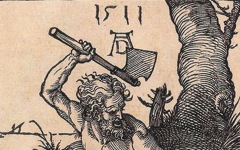Dürer’s Death of Orpheus (1494) and Descent into Limbo (1510)

Dürer, The Death of Orpheus (1494) pen and ink on paper, Kunsthalle, Hamburg
Click image to enlarge.
The drawing at left is of Orpheus, the legendary musician, poet and prophet, who was beaten to death by Maenads who could not hear his music. He is the ideal symbol for an artist struggling to make others hear his poetry although, in a perfect paradox, Dürer's Maenads also represent the artist beating (thus, allegorically "drawing") the artist as Orpheus. Orpheus' harp, abandoned in the foreground, appears to have the letter 'A' engraved on it directly above the AD of Anno Domini right at the bottom of the print, a timely and timeless pun on his own initials. (The date has unfortunately been cropped out of the reproduction at left.)
Click next thumbnail to continue

Left: Dürer, The Death of Orpheus
Right: Diagram of The Death of Orpheus revealing Dürer's own profile
Click image to enlarge.
The young artist clearly composed the outline to echo his own facial profile with its distinctive hooked nose. His "eye" is marked by the circular curlicue at the beginning of the banner. Although it is widely accepted that Dürer disguised faces and facial parts in drawings of both pillows and mountains, the veiled face here has never been noted. It confirms that what we see (the struggling and suffering artist beating his self-referential composition into shape) takes place in Dürer's mind or, literally, inside his head.
Click next thumbnail to continue
The same is true of his well-known engraving of Christ's Descent into Limbo. The archway forms the crown of a head just as the contours of the cloak flapping behind Christ's back describe an "eyebrow" and "eye" in shade with a "nose" in light.
Click next thumbnail to continue

Left: Diagram of a detail of Dürer's Christ's Descent into Limbo
Right: Dürer, Portrait of the Artist's Mother (1514), rotated and inverted
Click image to enlarge.
In comparing it to a drawing of the artist's mother from four years later the parallels are obvious, the family's divided chin amusingly represented by the buttocks of the infant holding the Cross. Although Descent into Limbo cannot have been based on this particular drawing, his mother's head is almost certainly drawn like his own (whether or not they resembled each other) and his youthful self-portraits hint that he too had a divided chin under his beard. It cannot be coincidence that the veiled face stares down into Limbo at the same angle as Adam holding the Cross whose gaze goes straight "through" the veiled eye. The intersection of the Cross, meanwhile, matches the "crown" of the head.
Click next thumbnail to continue

Left: Michelangelo, Last Judgement (1537-41) Sistine Chapel, Rome
Center: Diagram showing Dante's profile
Right: Life-cast of Dante's head in Palazzo Vecchio, Florence
Click image to enlarge.
We have shown elsewhere how the basic composition of Michelangelo's Last Judgment is composed around the profile of his poetic hero Dante Alighieri (see comparative diagram at left or separate entry). You can see several other examples by artists from Leonardo to Picasso under the theme Veiled Faces.
See conclusion below
The discovery of Dürer's profile within The Death of Orpheus confirms that Dürer's scene of Christ descending into Limbo is also in line with the allegorical beliefs of esoteric Christianity. As in the Orphic mysteries, mystical Christians believed (and still do) that divinity is universal and inside all of us and all of nature too. Look at the whole engraving again to see not only Durer's initials engraved on a stone near Christ's knees but the bottom portion of the broken door to Limbo lies in the lower left-hand corner. This prominent door-part, as so often in Dürer's oeuvre, refers to the family name because his grandfather chose it to sound like door in German.1 Thus the door to Limbo, a door into Dürer's own soul, is broken open by the Christ within his own mind as it begins the process of purification and, eventually, resurrection.
More Works by Dürer
On the surface this drawing by Albrecht Durer appears to be a simple portrait of Saint Dominic.

Dürer’s St. Dominic (1506)
Notes:
1. Joseph Leo Koerner, "Albrecht Dürer: A Sixteenth-Century Influenza" in Albrecht Dürer and His Legacy (London: British Museum) 2002, p.20
Original Publication Date on EPPH: 24 Aug 2011. | Updated: 0. © Simon Abrahams. Articles on this site are the copyright of Simon Abrahams. To use copyrighted material in print or other media for purposes beyond 'fair use', you must obtain permission from the copyright owner. Websites may link to this page without permission (please do) but may not reproduce the material on their own site without crediting Simon Abrahams and EPPH.



